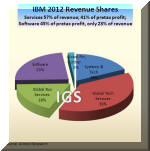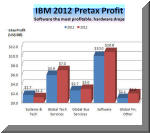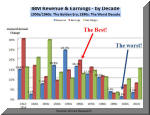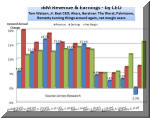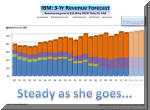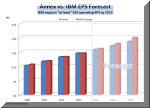
Annex Bulletin 2013-03 February 21, 2013
A partially OPEN edition
Apple Falls from Treetop (Analysis of latest market and business results of top 15 IT companies)
IBM CORPORATE
Updated 2/28/13, 10:00AM HST, adds IBM Analytics Update
Annex Research's 3-Year Forecast for IBM
Watson, Labs: Key to IBM Future
IBM looks inside to its research labs for sources of future growth; but world's emerging market Big Blue's most important growth engine
HAIKU, Maui, Feb 21, 2013 - "Steady as she goes" has been the theme of IBM's financial performance for the last several years. Big Blue isn't setting the world on fire, the way Apple did, for example, five years ago. Revenues actually declined in 2012 (click here for details). But IBM is nevertheless improving its profit margins and delivering on its promise of steady earnings growth at a $20 EPS in 2015.
That kind of a strategy - putting "Quality over Quantity" - is a refreshing change from the revenue-infatuated IBM under Lou Gerstner between 1993 and 2002. In many ways, the last decade under Sam Palmisano represented the company's return to some of its core values that had made it one of the world's greatest companies in the last 100 years. One of them is innovation.
Innovation
is also what Ginni Rometty's IBM is now t urning
to for sources of its future growth. Cognitive computing, nanotubes, quantum
computing, genomes, solar computer, nanophotonics, and, of course, the now
famous "Watson"
(the world champion of Jeopardy) are some of the areas 3,000 IBM scientists
in 12 global labs are mining. This is a quest of answers for business
solutions as well as scientific advances.
urning
to for sources of its future growth. Cognitive computing, nanotubes, quantum
computing, genomes, solar computer, nanophotonics, and, of course, the now
famous "Watson"
(the world champion of Jeopardy) are some of the areas 3,000 IBM scientists
in 12 global labs are mining. This is a quest of answers for business
solutions as well as scientific advances.
This writer recently had a chance to spend two days at the IBM premier research facility - the Watson Research Lab in Yorktown Heights, New York. By contrast to the business and finance which operate on a quarterly earnings release cycles, research thinks in terms of years and decades.
We are now
within 12 years of the end of the silicon lifetime, some IBM scientists
think. Basic computer architectures have not changed since the 1940s. Well,
now they will have to if IBM and the world are to advance to the next level.
So IBM researchers are working hard on alternatives to silicon, for example. New materials, never before seen in a computer, are being invented. Copper wire is being replaced by light (fiber optics). Carbon nanotubes are at the core of "neuralmorphic computing" or quantum computing. We may even see solar computers within the next 10 years.
Exciting stuff. Blue sky research at Big Blue. Yet it all has to be grounded somehow in a business solution in order to pay off for IBM shareholders. That's the hard part.
Which is
why such a challenge is an exciting playground even for seasoned business executives, such as Zachary Lemnios. Fresh off a 3.5 year
stint as the Assistant Secretary of Defense for Research and Engineering in
the first Obama administration, Lemnios is now the vice president in charge
of IBM's research strategy. As so many political appointees do, he
could have gone many places after his stint in Washington. He chose IBM.
Why?
seasoned business executives, such as Zachary Lemnios. Fresh off a 3.5 year
stint as the Assistant Secretary of Defense for Research and Engineering in
the first Obama administration, Lemnios is now the vice president in charge
of IBM's research strategy. As so many political appointees do, he
could have gone many places after his stint in Washington. He chose IBM.
Why?
Because he
was impressed by the depth and the range of Big Blue's research as a DoD
customer. Lemnios, who was the Chief Technology Officer at MIT's
Lincoln Lab before his DoD job, said a "clear strategic vision" that the IBM
CEO (Rometty) demonstrated, and the resources IBM has to pull it off were
also key factors.
What this writer was impressed by is that IBM's research and development is not only done in developed countries, like the U.S. The new Africa Lab in Nairobi is the latest case in point. In fact, IBM's record-setting 2012 patent total was accomplished by more than 8,000 IBM inventors residing in 46 different U.S. states and 35 countries. IBM inventors residing outside the U.S. contributed to nearly 30% of the company's 2012 U.S. patent output.
As a result, 2012 was the 20th year in a row that IBM was the world's most innovative company in terms of number of patents issued to it:
The Top Ten list of 2012 U.S. patent recipients* includes:
1 IBM 6,478
2 Samsung 5,081
3 Canon 3,174
4 Sony 3,032
5 Panasonic 2,769
6 Microsoft 2,613
7 Toshiba 2,447
8 Hon Hai 2,013
9 General Electric 1,652
10 LG Electronics 1,624
IBM said in statement that its 2012 patent count exceeded the combined totals of Accenture, Amazon, Apple, EMC, HP, Intel, Oracle/SUN and Symantec. It was also more than double that of Microsoft's 2012 patents. So there is no question that quantitatively IBM is the world champion of innovation.
"Dr Watson" Tackles Oncology
By now, everybody knows that IBM's "Watson" supercomputer is the world champion of Jeopardy. But few people realize that that was only a beginning. Watson has now moved on to new areas of human endeavor: Health Care. This is a wide open field for cognitive computing. And Watson is already making its presence known.
For more than a year, IBM has partnered separately with WellPoint and Memorial Sloan-Kettering to train Watson in the areas of oncology and utilization management. During this time, clinicians and technology experts spent thousands of hours "teaching" Watson how to process, analyze and interpret the meaning of complex clinical information using natural language processing, all with the goal of helping to improve health care quality and efficiency.
"IBM's work with WellPoint and Memorial Sloan-Kettering Cancer Center represents a landmark collaboration in how technology and evidence based medicine can transform the way in which health care is practiced," said Manoj Saxena, IBM General Manager, Watson Solutions in a Feb 8 release (click here for photos). "These breakthrough capabilities bring forward the first in a series of Watson-based technologies, which exemplifies the value of applying big data and analytics and cognitive computing to tackle the industries most pressing challenges."
To date, Watson has ingested more than 600,000 pieces of medical evidence, two million pages of text from 42 medical journals and clinical trials in the area of oncology research. Watson has the power to sift through 1.5 million patient records representing decades of cancer treatment history, such as medical records and patient outcomes, and provide to physicians evidence based treatment options all in a matter of seconds.
The bottom line, medical and computer researchers are hoping will be a cure for cancer. Starting with 1,500 lung cancer cases, Memorial Sloan-Kettering clinicians and analysts are training Watson to extract and interpret physician notes, lab results and clinical research, while sharing its profound expertise and experiences in treating hundreds of thousands of patients with cancer.
"It can take years for the latest developments in oncology to reach all practice settings. The combination of transformational technologies found in Watson with our cancer analytics and decision-making process has the potential to revolutionize the accessibility of information for the treatment of cancer in communities across the country and around the world," said Craig B. Thompson, M.D., President of Memorial Sloan-Kettering Cancer Center. "Ultimately, we expect this comprehensive, evidence-based approach will profoundly enhance cancer care."
IBM's Advances in Computational Biology
Similarly, IBM is making great strides in computational
biology. Dr Ajay Royyuru, Director of Computational Biology Center at the
Watson Lab in Yorktown Heights, said that sequencing of DNA used to cost $3
billion. Now it is about $10,000. We can expect it to cost $1,000 in
the near future and to be done in a clinician s
office, like X-rays.
s
office, like X-rays.
IBM also partnered with the National Geographic in a "Genographic Project." Its purpose is to genetically map human migrations over the millennia (see Mapping Human Family Tree). Dr Royyuru told us both IBM and the National Geographic were amazed by the public response. Over 580,000 people have already participated by providing their DNAs.
"People want to know who they are and where they've come
from," he said.

The maternally passed mtDNA was used to discover the famous "mitochondrial Eve" in 1987. Genetics has since extended to unequivocally show that the most recent common female ancestor of everyone alive today was an African woman who lived 200,000 years ago.
And those who want to know how they got from there into the body they occupy today, for $200 they can find out (click here to go to the Genographic Project web site). The National Geographic told me it takes about 6-8 weeks for results to be sent to the participant.
Alas, as we've already said, the hard part is translating innovation into revenues and profits. So much of our two-days of Watson Labs discussions focuses on that.
In his fourth quarter presentation to Wall Street, IBM CFO Mark Loughridge used this chart to illustrate where future growth would come from:
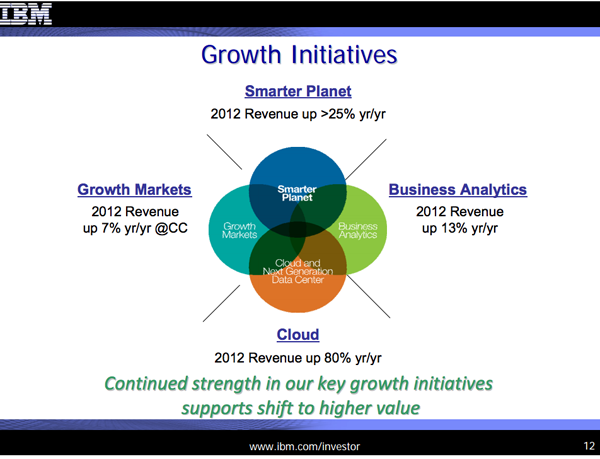
"We saw
tremendous expansion of our Smarter Planet growth initiative over the last
twelve months, measured in terms of offerings, markets, customers, and
revenue," Mark Loughridge said on Jan 22. He added that the Smarter
Planet revenues grew 25% year-over-year in 2012 (click
here to view IBM P&L table).

Erich Clementi (right), Senior Vice President of IBM Global Technology Services, elaborated for us on the other three of the four main growth initiatives. The Growth Markets have both been, and will continue to be, the largest source of IBM's new growth.
We estimate that in 2012, for example, the Growth Markets accounted for about $25 billion of IBM's revenue, or 24% of the total. By 2015, their share should grow to about 30%. Which would make growth market about a $33 billion global business, growing at 10% annually. That's much faster than the growth of IBM's overall revenues, which we expect to be in the low single digits.
Analytics comes second in revenue size (about $12 billion currently, $16 billion in 2015), Cloud third ($7 billion, $3 billion incremental revenue). In 2012, Analytics grew 13%, the Cloud business over 80%.
UPDATE 2-28-12: Speaking at the IBM Almaden Labs in San Jose, CA, on Feb 28, IBM CEO Ginni Rometty told the Wall Street analysts attending an Investors' Day there that the company now expects to exceed its earlier Business Analytics revenue projection for 2015 by $4 billion.
"We'll take analytics up from $16 to $20 billion in the 2015 timeframe," Rometty said.
Rometty told the investors right at the outset that IBM wanted them to focus on long-term strategic issues today, not short-term quarterly results.
"We are here today to focus on the long term. We're going to talk about our strategic initiatives... We're not here to talk about the current quarter of the year. And so we will be making a number of forward-looking statements."
And that's exactly what she then proceeded to do, including making the pronouncement about the bump in business analytics that grabbed today's headlines. Nevertheless, IBM shares fell 0.7% to $200.83 by the end of the day's trading. So much for trying to get Wall Street to think long-term or strategically. Guess that's an oxymoron on a street where everybody is transaction-driven and "tomorrow" is a long-term notion.
Annex's 3-Year IBM Forecast
Putting it all together, what does all this mean for IBM business outlook? For one thing, it means Big Blue will still be around by the time the silicon era runs its course. And it will be shaping the course of the IT history in the decade after that. That's more than we can say about some other global IT giants which face extinction (HP, for example).
Staying in the race with the young IT upstarts is no small feat given that Big Blue will be more than 110 years old by then, and is operating in the fastest changing industry in the world. To do so, IBM will have to reinvent itself every day. Just as it has been doing for most of the last century. When it stopped, as it happened under John Akers' leadership in the late 1980s, the company stopped growing. Massive losses followed. Big Blue almost bit the dust.
When new leaders took over, IBM resumed the reinvention process. As a result, IBM managed to outgrow the U.S. GDP by 10.5% to 5.8% during the last century. There is no other computer company around that can boast that kind of a record. Some have led the segments of the industry for a while (Univac, DEC, Amdahl, Compaq...). But eventually they ran out of steam. Their creative energies got depleted first, then reinvestment funds. Then they died.
IBM's longevity amid the industry carnage is a remarkable feat, especially considering how many different wars, presidents, recessions and depressions the world has gone through in the last century. Take a look at these charts which show IBM's 100-year revenue history...
You can see the five dips in the last 20 years, each caused by different phenomena. Some were even good for IBM. The first two (Akers, Gerstner) were caused by executive incompetence. Clearly, that's bad. The third and the fifth, however (PC, Pruning), were are result of deliberate management actions to taken to shed low or no profit businesses and improve profit margins. That's good. [click here to view IBM CEO tables]. It's like surgery to remove unproductive or harmful tissues.
As a result, IBM revenues dropped in 2012. Yet its net margin set a 63-year record. Yes, a record! Last year was better than even the hay days of IBM and computer industry (the 1950s and 1960s). Not since 1949, have the IBM shareholders seen a 16% or better profit margin.
But the best growth years for IBM were the 1960s. That's when IBM revolutionized the industry with its S/360 mainframe computers. The compound revenue and earnings growth peaked at 13.8% and 14.1% respectively. Tom Watson, Jr. was the chairman and CEO at the time.
Ever since, both revenue and earnings growth rates have been declining. They stand at 10.5% and 10.9% respectively as of 2012. For the last five years, however, they have been 0.9% and 8% respectively. So the long-term trend is down.
Which goes to show us that "pruning" service contracts or cutting the fat elsewhere, cannot be a good recipe for long-term growth. So back to the lab - IBM's "innovation factory." That and the world's growth markets (which we used to call emerging or developing countries) will have to be the engine of future growth for Big Blue.
But long-term solutions like that take a while to kick in. So don't expect any immediate spurts in IBM revenue performance. In fact, we see IBM growing at about 2% per year in the next three years. Which is actually better than the 0.9% compound actual growth IBM reported in the last five years, and is roughly in line with its 2.6% 10-year growth. Yet at the same time, IBM managed to grow its net profit at 7% to 8% compounded annually (see IBM History, PDF).
Which is
why, barring some global economic calamities in the next three years, we
expect the company to come pretty close to its $20 EPS
goal in 2015.
Meanwhile,
"buy on rumor, sell on fact" continues to be a good trading tactic when it comes to the IBM stock. As you can see from the chart (right),
IBM shares tend to rally before the quarterly earnings releases. And
then as the euphoria of the IBM executive comments wanes and fades away, so
do the stock prices. Which also goes to show us that it will take more
than talk to sustain the IBM share growth in the future.
comes to the IBM stock. As you can see from the chart (right),
IBM shares tend to rally before the quarterly earnings releases. And
then as the euphoria of the IBM executive comments wanes and fades away, so
do the stock prices. Which also goes to show us that it will take more
than talk to sustain the IBM share growth in the future.
Back to Watson et. al. ... The floor is yours.
Bob Djurdjevic
![]()
Volume XXIX, Annex Bulletin 2013-03 Bob Djurdjevic, Editor
(c) Copyright 2013 by Annex Research,
Inc. All rights reserved. |
Home | Headlines | Annex Bulletins | Index 1993-2013 | Special Reports | About Founder | Search | Feedback | Clips | Activism | Client quotes | Speeches | Columns | Subscribe
HP: Duped, Down and Out? (Analysis of HP's business and stock results)
Same Old Story, New Numbers Underscore Lack of IBM Growth (Analysis of IBM's third quarter business results)
Lack of Growth: IBM's Achilles Heel (Analysis of IBM's 2Q12 business results)
Apple Continues to Dominate (Analysis of top global IT companies' market and business results)
Big Blue Feet of Clay (Analysis of IBM first quarter results and long-term forecast)
Wall Street in Love! (No Signs of Caution on Ides of March, IBM Forecast Overshadowed by Wall Street Action)
Waning of PC Era Hurts HP (Analysis of latest HP business results)
Apple Leaves Everybody in Dust (Analysis of latest market and business results of top 15 IT companies)
Apple, IBM Clean Up, Google Stumbles (Analysis of fourth quarter business results of five major IT companies - Apple, IBM, Microsoft, Intel and Google)
